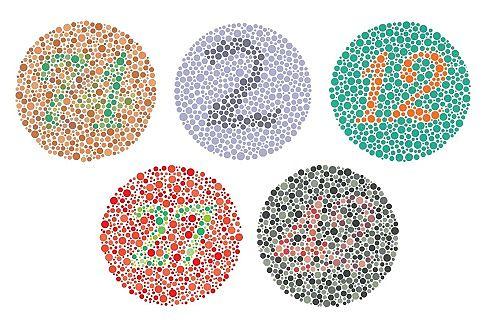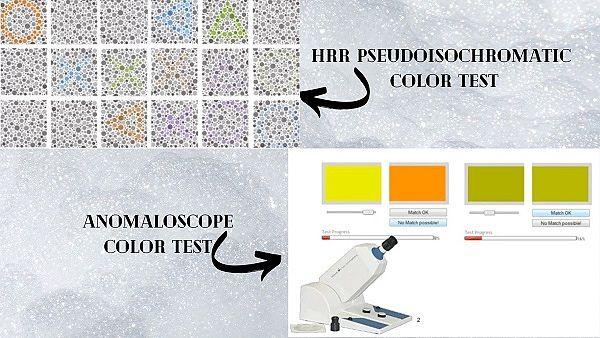Seeing the world without all the colors doesn't mean seeing the world without any colors at all. Rather, it's a condition that affects the way people perceive colors. Color blindness test offer a captivating journey to uncover the secrets of our unique perception.
Imagine being in a paint store, surrounded by countless hues of paint chips, yet unable to distinguish between certain shades of red and green, or blue and yellow.
Reds may look green or even black, while yellows may appear as shades of gray. This is what life is like for those with color blindness.
Our eyes contain specialized cells that allow us to see colors, but people with color blindness have a deficiency in one or more of these cells.
As a result, their brains struggle to translate certain wavelengths of light into the colors we see. While most people have trichromatic color vision, which allows us to see red, green, and blue hues, those with color blindness have dichromatic or even monochromatic vision.
Despite its challenges, color blindness can be managed with various tools, including specialized glasses and assistive technology. Understanding color blindness is crucial to appreciating the unique perspectives and experiences of those who live with it every day.
Did you know that our eyes are specially designed to detect a rainbow of colors that even some animals can't see? It's all thanks to a remarkable part of our eyes called cones, which are responsible for translating the spectrum of light into vivid hues that we can see and appreciate.
These tiny but powerful cones contain pigment molecules that come in the primary colors of red, green, and blue. Each pigment responds to a different wavelength of light, allowing our brains to distinguish between the countless colors that make up our world. But what happens when one of these pigments is deficient or missing altogether?
That's when the perception of colors becomes skewed, resulting in color blindness. It's a condition that affects millions of people around the world, making it difficult to distinguish between shades of red and green or blue and yellow.
But with the help of modern technology and scientific breakthroughs, we can now better understand the complexities of color perception and find new ways to help those affected by color blindness.
Understanding Color Blindness Causes
Color blindness is a genetic condition that is caused when the color detecting parts of our eyes, the cones, lack some of the molecules the body needs to see all the shades of a color.
It affects males for than females because the X gene carries it, of which men have two, making it a dominant feature.
Injuries to the eye or chemicals may affect how the eye perceives colors. If the cones are damaged in any way, then so is the ability to differentiate between shades of color.
Color perception may decline with age as well and can be affected by cataracts, a film that covers the eye.
Navigating the Different Forms of Color Blindness
There are three main types of color blindness:
- Red-Green Color Blindness
- Blue-Yellow Color Blindness
- Monochromatic or Complete Color Blindness
There are also varying degrees of severity within each category of color blindness. Some people experience a mild form, which may have little to no impact on everyday life and may not ever be aware of unless they attempt one of the more subtle versions of a colorblind test. There may also be more severe effects, which may require adaptations in order to function safely in the everyday world.
Color Blindness Tests
Eye care professionals can diagnose color blindness fairly quickly. There are several tests that have been in use for years and vary in the requirements for color discrimination.
As with anything involving vision, results may be affected by ambient lighting, the condition of a printing, or even differences in computer monitors. If issue with color detection is suspected, see an eye specialist to confirm.
Ishihara Color Test

This test is the most common test used to detect color blindness. It was developed during World War I by Dr. Shinobu Ishihara and improves on a German test, which existed at the time.
It consists of a series of plates which have an image, usually a number or squiggly line, made of dots of different shades of color. It cannot only determine if color blindness is present but may also reveal the severity of the condition. Color blindness can usually be detected within two to three plates.
It may have some discrepancies due to being a printed plate and therefore being dependent on the quality of the printing.
Cambridge Color Test
This test is very similar to the Ishihara Test except it is administered on the computer. It shows the image of a letter C made of different colored dots. Respondents press a button to indicate whether or not they perceive the letter. This test may remove some of the discrepancies found in the printings of the Ishihara test.
Anomaloscope
This test may be considered one of the most accurate test when diagnosing color blindness. It asks the respondent to make a test color match a sample color and report whether or not a match is possible. It then gives a report that shows whether or not color blindness is present and which colors are affected.
 HRR Pseudoisochromatic Color Test
HRR Pseudoisochromatic Color Test
This is another test which uses plates to test for color blindness. An image is presented in a monochromatic background using different shades of a target color. It is very similar to the Ishihara and Cambridge test and is just as accurate.
Farnsworth-Munsell 100 Hue Test

This is an assessment of hue discrimination. This test can help to reveal the severity of a colorblind person’s condition. Many people who attempt this assessment may find that they suffer from a mild form of color blindness of which they were previously unaware.
This test asks respondents to order a series of 100 plates or pegs in order of hue. Some employers use this test before hiring, since there are few jobs, which depend on subtle color perception. This includes graphic design and food quality detection.
Farnsworth Lantern Test
This is an assessment of ability to detect different colors of light used by military vessels. It is given to Naval sailors and pilots who may be required to determine the presence and meaning of different lights. The test consists of a lamp with a vertical light of 9 colors and the respondent is expected to compare them.
There are varying degrees of color blindness acceptability based on the branch of the armed forces, so minor color blindness may not prevent enlistment.
What are the Effects of Color blindness?
School
Color blindness is usually diagnosed in childhood, as children are required to interpret information that has been color-coded. This includes visual information such as graphs and charts, which usually have differently colored sections to separate the information.
Children may also experience difficulty in choosing the correct color of crayon or paint. This can make art classes challenging.
Food
People also depend on color acuity to determine the ripeness of fruits and vegetables. Rot is often detected by a darker shade of the normal color. Thorough cooking of meat is often stated in terms of the color of the interior of the meat.
Everyday Tasks
Traffic lights can be a challenge but most have a predictable orientation of color progression with green on top and red on bottom. When presented with traffic lights in a horizontal orientation, it may require more mental attention to attend to the new sequence of lights.
Reading maps may require assistance if they are color-coded by area or feature and buying clothing that match in color can be difficult, however many smartphone apps have been developed to assist in this matter.
Some countries limit driving licenses for colorblind citizens. It has been argued that it is a matter of safety due to traffic lights or warning signs that are present on the road.
Careers
Color blindness may also limit career choices, particularly those which rely on a ability to differentiate between warning signs of varying shades but do not include textual clues.
Some careers rely on being able to see all shades of color such as mixing paints or graphic design. Jobs which require different types of cable, like computer networking or electricians, may not be accessible to those who are colorblind.
Commercial piloting requires unaffected color acuity, but it is possible to obtain a pilot’s license for smaller planes such as those used for agriculture.
Color blindness may not allow people to apply for the Air Force but does not limit other branches of military service.
What are the Treatments for Color Blindness?
As it is primarily a genetic disorder, there is no cure for color blindness. It is often not detected until a child is old enough to indicate that they are experiencing issues with color.
However, there are methods to allow a colorblind person to experience as little interference with everyday functioning as possible.
People with red-green color blindness can use tinted lenses to help them detect these colors more accurately. These can be glasses or contact lenses. They may have issues in dim light or indoors, since ambient lighting can affect color perception.
Technology has improved to the point that many smartphones now have applications, which can detect the color when a photo is taken, or the user points the camera at an object. These apps can be useful when looking for ripe fruit in the supermarket.
Conclusion
This article has shown that color blindness is a common condition that can be overcome with the help of technology and inclusive practices. By raising awareness and embracing diversity, we can create a world where everyone can fully appreciate the beauty of colors. Let's celebrate humanity's vibrant spectrum and foster empathy for those with color vision deficiencies.
If you've found this post to be a valuable resource, why not spread the knowledge and share it with your friends and family on WhatsApp and Facebook? After all, everyone deserves to have a colorful and vibrant life, so let's make sure we're all seeing it in the best way possible!
